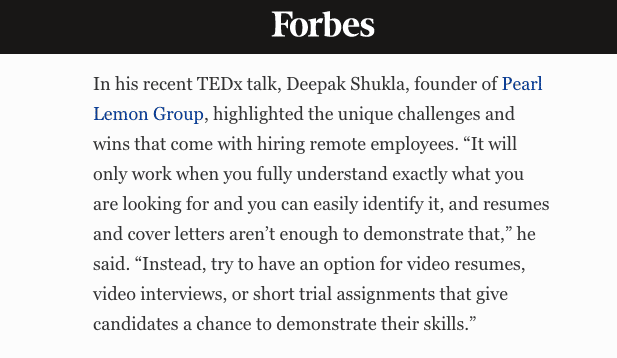There’s a lot of confusion about this form of public relations all over social media. Some people think that digital PR is a glorified form of link building; others think it’s nothing more than spamming journalists with emails.
Both of those misconceptions are due to digital PR being a relatively new form of public relations. Not many PR agencies even specialize in this because most communication firms would prefer to stick to traditional public relations.
Times have changed from what public relations used to be. The rise of social media and the explosion of blogs and digital publications has forced the PR industry to pivot.
The goal of digital PR is to get clients in publications that their audiences engage with the most. Those platforms are increasingly becoming digital, which is why digital PR is rising.
Types of digital PR include:
Don’t worry; these digital PR types will be explored further. But first, let’s answer some of the most common questions that people have about digital PR.
Absolutely not.
Link building strategies can be used to enhance a digital PR campaign, but that doesn’t mean that link building and digital PR are the exact same thing.
Link building focuses on gaining do-follow links from different websites online. It doesn’t matter if the publication is relevant, has a great readership, or if the brand name is even mentioned. The aim is to get a backlink – period.
Some link builders even place links on spam websites that nobody reads because they are just trying to build a large backlink profile.
Link building can be helpful for building a better website, improving its SEO, and increasing its domain rating.
On the other hand, digital PR focuses on the brand. Whether that is a personal brand or a company brand doesn’t matter. A digital PR specialist is not going to try to get the brand’s links in just any publications. In fact, it’s not even about links. It’s about brand features, exposés, exposure, and media opportunities that help potential customers engage with the brand’s content.
Digital PR aims to:
On the other hand…
Link building aims to:
Get it now?

Imagine that you have a sneaker brand and want to launch a new collection in a few months, but you want to brand it differently this time. In order to do that, you’d need to use a digital PR campaign to control the perception and narrative about your new collection.
Sure, you could publish one press release and have a few cute photos of your collection on PR Newswire. But that’s not enough. You have to dig deeper.
As a Digital PR Manager, here are some of the strategies I’d use in this scenario:
1. Define what narrative you want to promote about your brand.

2. Analyze what your target customers are looking for, complaining about, and excited about in the industry based on a social media analysis and market research.

3. Look for niche blogs, review sites, podcast shows, and Youtubers that are trusted by your target audience to see what kind of approach will be well-received.

4. Look for tier-1 publications that cover fashion, innovation, fashion news, etc.

5. Create shareable content that journalists can reuse for their articles and quote you and your brand (plus a link).

6. Do media outreach to get your brand featured, get you and your team interviewed, and provide quotes about trending topics in fashion relating to sneakers.
This process is carefully curated to ensure that every single media feature is relevant, authoritative, and profitable for your brand. A lot of these strategies have the same goal. Digital PR takes time to perfect, but the results are much faster than other marketing strategies.
The best part, in my opinion, is that those media features are online forever. Your brand name is important for your overall reputation, so it’s important to make sure that the publications you’re featured in are relevant and authoritative.
We got our founder, Deepak Shukla, featured in publications like Forbes, where he shared his expertise in recruitment.

This feature led to a do-follow link from a high DA website and credibility from a high-profile digital publication. This media feature can now be used as a building block for landing features in other tier-1 publications and so on and so forth.
The picture ties together perfectly.
Digital marketing and link building don’t achieve these results because they serve different purposes. Digital PR is at the forefront of building strong brand reputations that have long-term benefits.
Full disclosure: this list mainly contains my top favorites. We’ve used these digital PR strategies at the forefront of our campaigns for years and have seen results.
This form of digital PR is about getting a client brand features that build up their thought leadership. This means that a client is featured in authoritative publications based on their expertise.
Here’s an example:
You specialize in dermatology, and you’re starting a private practice. To build your thought leadership, we’d ask you about topics in which you are an expert. This could be skin care products, wellness, and beauty products. Since the launch of skincare brands from celebrities like Kim Kardashian, Rihanna, and Lori Harvey, there’s a lot of buzz about it in the skincare community.
This would be your opportunity to share your expertise on the topic. What do you think about celebrities having skincare brands and they have no qualifications or expertise in dermatology? You can use your expertise to tell journalists about what risks are involved in buying just any skincare product. You can share your research with publications that are covering that story and set yourself up as an expert in that niche topic.
The results?
Your name will be out there in publications that are widely read by your target market. Your potential customers will find you through the links associated with your research and your brand name. That will lead to increased organic traffic, a growing brand presence, and a strong reputation in your field.
You can use thought leadership in many ways, but the goal remains the same. This strategy got me featured in Business Insider for the research that I’d published about diversity and inclusion in the PR industry.

I used my expertise in the D&I field to land this media opportunity. That doesn’t mean that I specialize in D&I; it just means that it is one of many topics that I have researched and have expertise in.
This is a similar model that we try to emulate with all our clients, and it’s a highly recommended strategy. When you approach digital PR in this way, you are investing in your business’s long-term reputation, and that pay-off is incredibly important.
This is one of the most exciting digital PR strategies that focus on getting your client featured in dozens of publications covering a trending topic. Remember when JLo got engaged for the 500th time this year?
Her green diamond ring was a trending topic in major news publications; if your client owns a jewelry brand, then that’s your moment to let them shine. That client can comment on the type of diamond ring JLo received, how rare it is, how much it costs, and other affordable alternatives that ordinary people can get for their finances.
This can lead to a ton of media opportunities because trending topics need sources, and journalists will be on the hunt for research, statistics, and expert quotes from experts on those topics.
Newsjacking can be done in many different ways, but the main thing that PR specialists must pay attention to is what is trending on the news and what is closely related to their client’s niche. Not every trending news topic is an opportunity to newsjack. It takes experience to be able to identify which topics are worth pursuing specific clients.
This can’t work for all clients because more formal, corporate clients are more interested in quality over quantity and may not be pleased with a Buzzfeed media feature. When you have super picky clients, tread carefully with this strategy because it can get out of hand. You can get republished in dozens of publications in a matter of hours, and there’s not much you can change once the articles go live.
However, newsjacking can work really well for their campaigns if you have a client who wants as much press as possible and as many eyeballs on their website.

Whenever a journalist tweets about a question they need to be answered for an article they’re working on, you should know about it. Whether they need responses in 24 hours or less, your media strategy should make that happen.
Online media outreach is the cornerstone of digital PR, and countless tools are available to make that process easier. You should see my inbox; it’s never empty. There are hundreds of media requests that I receive on a daily basis, and they each give me an opportunity to help a journalist enrich their article.
Here are some of my top media request tools:
I use these six main tools daily to scout for new media opportunities. Response Source and Dot Star Media are my favorites because they have some of the top journalists in the world sending in their media requests. Through tools like these, I’ve gotten clients featured in Business Insider, BBC, Forbes, London Daily News, Cosmopolitan, Marie Claire, and several others. Digital PR has opened doors for innovative tools that help PRs connect with journalists in a mutually beneficial way.
Even without tools like these, it’s possible to get media features. This is why digital PR is so close to my heart: it strips down all the formalities with which traditional PR boxed us in. Social media lets you connect with editors, event organizers, reviewers, and journalists to arrange PR opportunities for your clients.
Just by using my LinkedIn, I landed two speaking opportunities for Deepak Shukla to give TEDx talks. These were huge for his personal brand and for Pearl Lemon Group as a whole.

All that was done using online media outreach. I contacted the organizers via LinkedIn, pitched Deepak’s ideas, and connected them to meet online and prepare for the events. Now, you can find his TEDx talks published online.
Online media outreach can be a hit or miss; it takes time to perfect. I’ll write another blog about how to get it right.
Digital PR is transforming the public relations industry. It is my favorite form of marketing and can drive great results when done right. Though it is often mistaken for link building, it is clear that digital PR is so much more than just landing links.
It is a great way to build a strong brand presence and online reputation and drives sales. With a combination of newsjacking, online media outreach, and thought leadership brand features, your brands can get to the next level. So when someone asks you what digital PR is, just send them this article! If you’d like to stay up to date with what’s going on in digital PR and the results that me and my team are generating, follow me on LinkedIn.
Company Address:
Pearl Lemon PR
Pearl Lemon Ltd.
Kemp House, 152 – 160 City Road
London, EC1V 2NX
United Kingdom
Contact Us:
UK: +442071833436
Pearl Lemon PR is a part of the Pearl Lemon Group which is comprised of: SEO Agency London, Lead Generation, Lead Generation USA, & Web Development related services.
© All Rights Reserved | Company Number: 10411490 | VAT Number: 252 7124 23
Page Sitemap | Post-Sitemap Privacy Policy |Term of Services